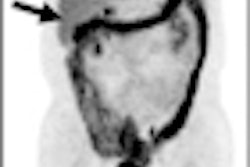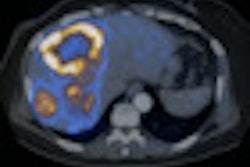A decision by the U.S. Centers for Medicare and Medicaid Services (CMS) to approve payment for FDG-PET scans for colorectal cancer patients led to 41% growth in use of the modality at one hospital, according to a study in the February issue of Radiology.
Researchers at the Hospital of the University of Pennsylvania in Philadelphia, led by Dr. Hanna Zafar, found "substantial growth" in FDG-PET procedure volume at their facility among patients who were operated on during the first 18 months after CMS coverage began in July 2001 (Radiology, 2010, Vol. 254:2, pp. 501-508).
Colorectal patients
The retrospective study reviewed postoperative FDG-PET use in patients with colorectal cancer between July 2001 and December 2002. The researchers used Surveillance, Epidemiology, and End Results (SEER) colorectal cancer files to identify patients, and they reviewed their outcomes during the following two years via SEER-Medicare files.
Zafar and colleagues narrowed the number of patients in the sample to 10,630 individuals, all of whom had undergone resection for colorectal cancer during the 18-month study period. In all, 1,056 (10%) patients underwent at least one FDG-PET exam within two years of surgery. The patient sample included 757 patients with colon cancer and 299 patients with rectal cancer. The mean age of the study group was 77.5 years.
To examine the effects of reimbursement on PET use, they segmented the patient population into six-month intervals following the Medicare reimbursement decision, and looked at the number of patients within each period who received PET scans.
The researchers found that in the six months immediately after reimbursement began, 8.5% of patients received a PET scan (300 out of 3,516). PET use didn't change dramatically in the period six to 12 months after coverage started, with the PET usage rate edging up to 9.1% (317 out of 3,466). But in the period 12 to 18 months later, PET usage jumped to 12% (439 out of 3,646). That represents growth of 41% over the early study period (p < 0.001), according to the authors.
At the same time, CT utilization barely changed across the study periods. In the zero- to six-month period, 63.7% of patients received CT scans, compared with 64.8% in the 12- to 18-month period, a difference that was not statistically significant (p = 0.302).
Other findings
In other findings, the authors reported that patients were evenly divided among those who had surgery during the study period, with 3,516 patients having follow-up surgery in the first six months and 3,466 patients having surgery between six and 12 months. In the later six months, 3,648 patients were treated surgically.
The researchers found that of the 1,056 patients who underwent at least one FDG-PET examination, 246 (23%) patients underwent more than one FDG-PET exam, including 196 (19%) who received two FDG-PET scans. By comparison, 6,786 (63%) of 10,630 patients in the study received one or more CT scans within two years of surgery.
Of the primary tumors detected, 8,350 (79%) of 10,630 patients had tumors in the colon and 2,280 (21%) patients had tumors in the rectum. Most of the patients (3,659 or 34%) were diagnosed with stage II cancer, while 3,052 patients (29%) had stage III disease. Fewer patients (1,334 or 13%) were found to have metastatic disease.
The researchers concluded that the highest utilization of FDG-PET was during the first six months following surgery. Significant predictors of higher FDG-PET utilization included rectal cancer, later date of initial surgery, higher disease stage, older age of the patient, marital status, and lower comorbidity.
"Higher utilization of FDG-PET in the early postoperative period compared with subsequent periods suggests that this technology may be driven by difficulty interpreting CT results in the early postsurgical period and/or the desire for more aggressive monitoring of patients for residual or recurrent disease," the authors wrote.
Greater early postoperative utilization of FDG-PET, they added, may have been prompted by "concern for tumor left in the operative bed and/or more aggressive monitoring of patients for disease recurrence in the early postoperative period compared with subsequent periods."
By Wayne Forrest
AuntMinnie.com staff writer
January 26, 2010
Related Reading
FDG-PET distinguishes Parkinson's from other disorders, January 11, 2010
FDG-PET/CT trumps CT in detecting anal carcinoma, November 25, 2009
FDG-PET faces off against MDCT for gallbladder carcinoma, November 3, 2009
FDG-PET uptake helps predict vascular events in cancer patients, October 9, 2009
FDG-PET aids in detecting atherosclerosis activity, February 23, 2009
Copyright © 2010 AuntMinnie.com



















